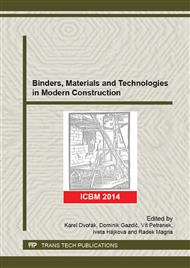p.81
p.87
p.91
p.97
p.101
p.106
p.112
p.116
p.120
Sulfuric Acid Attack on Various Types of Fine Grained Concrete
Abstract:
Sulfate corrosion is one of the major threats for durability of concrete constructions and it becomes a major destructor in sewage collection systems where the concrete sewer pipes are exposed to sulfates from wastewater as well as from biogenic activity of bacteria. During this process the pH of the surface of concrete sewer pipes is reduced and it may lead to steel depassivation and results in the corrosion of this steel reinforcement. This paper is focused on the sulfate attack on fine grained concrete where the effect of 0.5% sulfuric acid, simulating biogenic sulfuric acid corrosion, on changes of pH and content of sulfates in various types of concrete has been investigated. After 3 and 6 months of the corrosive treatment, the content of sulfate ions and pH values in several layers of specimens were determined. It was found that the sulfate ions penetrate into concrete to the maximum depth of 20 mm and the pH of the aqueous leaches of particular layers of the samples was reduced to 11.4 at the most. Thus, the conditions for the depassivation of reinforcement were not met. The GL and GBFS concrete samples showed the least changes of their pH and therefore they had the best resistivity to the six months sulfate attack.
Info:
Periodical:
Pages:
101-105
Citation:
Online since:
April 2015
Authors:
Keywords:
Price:
Сopyright:
© 2015 Trans Tech Publications Ltd. All Rights Reserved
Share:
Citation:


